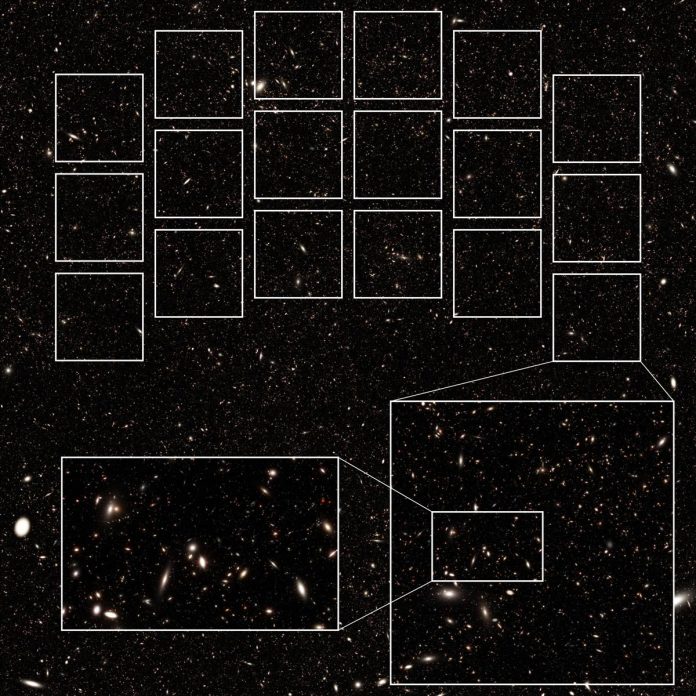Astrophysicists have created an image that shows how the Nancy Grace Roman Space Telescope will conduct a mega-exposure. This will be far larger than Hubble’s celebrated Ultra Deep Field Image. The Hubble observation have changed our view of the early universe. It has revealed galaxies that formed just a few hundred million years after the big bang.
Using the Hubble Ultra Deep Field image, astronomers pulled aside the cosmic curtains and revealed an empty slice of the sky which was teeming with thousands of galaxies. The Hubble team harnessed the power of a long exposure time which was hundreds of hours between 2002 and 2012. This has allowed the telescope to collect more light than it could in a single observation. The images helped us see more than 13 billion years back in time.
Hubble’s Ultra Deep Field offered us a window to the early universe. But it was a narrow one. It has covered less than one ten millionth of the whole sky. Roman will have a similar observation on a much larger scale. This will reveal millions of galaxies instead of thousands. Roman ultra-deep field will be sharp and it will reveal an area 300 times larger than Hubble. This will offer us a larger view of cosmic ecosystems.
Scientists have created a synthetic catalog of galaxies in Roman ultra-deep field image. Scientists have created a mock universe which is based on synthetic galaxies on dark matter simulations. They also made this galaxy catalog publicly available. Scientists also created an interactive website for users to pan across the full-resolution image.
Looking far and wide
Roman will be able to cover an enormous field of view and infrared vision. Astronomers will be able to peer far and wide at the same time. This will open up new avenues of cosmic exploration.
Roman ultra-deep field program will reveal more than a million galaxies scattered throughout cosmic history. It will reveal very young and small galaxies just beginning to form stars to the modern era. Scientists would be able to know galaxies transition from forming lots of new stars to when star formation is complete.
The reasons of this metamorphosis are not well understood. Roman’s wide viewing power will offer us clues about how a galaxy’s environment affects its star formation.
Galaxies in which star formation has ended is called quiescent galaxies. Roman is able to image large patches of the distant universe. This reveals both rare and faint objects which helps astronomers to find as many as 100,000 quiescent galaxies. Roman ultra-deep field observations will help astronomers to determine whether galaxies transition from star-forming to quiescent differently in different cosmic eras.
The end of the cosmic ‘dark ages’
Roman can also illuminate our understanding of a cosmic event called reionization. After the big bang, the universe was filled with a hot sea of plasma which formed ionized fluid. After the universe cooled, the particles sticked together and formed hydrogen atoms which created neutral hydrogen fog. This caused the cosmic “dark ages” as this fog prevented shorter wavelengths of light.
But the neutral hydrogen atoms broke apart. The fog lifted and made the universe from being mostly opaque to the brilliant starscape we see today. NASA’s Spitzer Space Telescope suggested that the first galaxies released extremely high amounts of ionizing radiation.
Roman ultra-deep field program can improve our understanding of the epoch of reionization with images containing more than 10,000 galaxies from this relatively brief cosmic age. This cosmic age happened sometime between when the universe was around 600 million to 900 million years old. This will help astronomers to understand what caused reionization.

